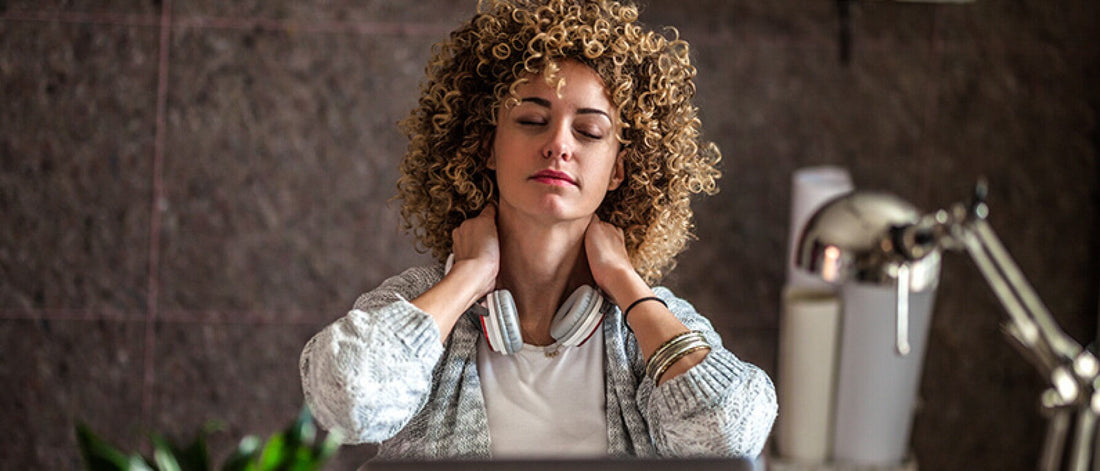When you experience stress or anxiety, the affiliated emotions can manifest in the physical body as muscle tension. Have you ever noticed an ache in one of your shoulders or a knot in your lower back before a tough conversation with someone or after you’ve had a stressful day at work?
Muscle tension is the body's way of trying to protect itself against injury and pain. Tension strains and hardens your muscles and, over time, that can cause your muscle groups to experience both dull and sharp pains.
Progressive muscle relaxation, also called Jacobson's relaxation technique or deep muscle relaxation, can help release tension held in the body. The method was invented in the 1920s by Dr. Edmund Jacobson, an American physician of internal medicine and psychiatry and also a physiologist. His focus was on helping his patients manage anxiety; he believed relaxing the muscles could also relax the mind.
Research shows that people use progressive muscle relaxation exercises to help with a variety of health concerns including:
Some people prefer to use a guided approach, where you listen to an audio recording of someone who instructs you through tensing and relaxing each muscle group. Others prefer to memorize a relaxation sequence and do the practice by memory. Either way, it’s important to be in a location that’s quiet and free of interruptions. Once you’re there:
If you want to memorize a sequence and guide yourself, here’s one that can be used:
1. Right hand and forearm: Make a fist with your right hand. Release.
2. Right upper arm: Bring your right forearm up to your shoulder and make a muscle. Release.
3. Left hand and forearm: Make a fist with your left hand. Release.
4. Left upper arm: Bring your left forearm up to your shoulder and make a muscle. Release.
5. Forehead: Raise your eyebrows as high as they will go, as though you were surprised by something. Release.
6. Eyes and cheeks: Squeeze your eyes tight shut. Release.
7. Mouth and jaw: Open your mouth really wide, as if you’re yawning. Release.
8. Neck: Be very careful as you tense these muscles. Face forward and then pull your head back slowly, as though you are looking up to the ceiling. Release.
9. Shoulders: Tense the muscles in your shoulders as you try and touch your ears to your shoulders. Release.
10. Shoulder blades and back: Push your shoulder blades back, as if you’re trying to touch them together, so that your chest is pushed forward. Release.
11. Chest and stomach: Breathe in deeply, and completely fill your lungs and chest with air. Release.
12. Hips and butt: Squeeze your butt muscles. Release.
13. Right upper leg: Tighten your right thigh. Release.
14. Right lower leg: To avoid cramps, do this slowly. Pull your toes toward you to stretch your calf muscle. Release.
15. Right foot: Curl your toes downward. Release.
16. Left upper leg: Tighten your left thigh. Release.
17. Left lower leg: To avoid cramps, do this slowly. Pull your toes toward you to stretch your calf muscle. Release.
18. Left foot: Curl your toes downward. Release.
19. Now that you’ve gone through all of the muscle groups, count backward from five to one to bring your focus back to the room.
Some experts prefer a relaxation training sequence that starts at the feet and moves up the body. But it’s your preference and find what you works best for you.
Progressive muscle relaxation audio (and video) guides can be found on YouTube via simple searches. There are also apps like InsightTimer and Pacifica that offer different guided sequences to help you release stress and muscular tension.
If you choose to explore these types of relaxation exercises, practice often. Practice will make the sequence, whether guided or memorized, more intuitive and effective when you truly do need to relax. You may have to try a few different sequences—and do them several times—before you find one that allows you to stay focused and ultimately ease into a sense of relaxation.
*Editor’s Note: The information in this article is intended for your educational use only; does not necessarily reflect the opinions of the Chopra Center's Mind-Body Medical Group; and is not a substitute for professional medical advice, diagnosis, or treatment. Always seek the advice of your physician or other qualified health providers with any questions you may have regarding a medical condition and before undertaking any diet, supplement, fitness, or other health program
Ready to start flowing with the Universe, instead of against it? Learn a natural, effortless style of meditation that helps make every day feel easy, fresh, and fulfilling with Basics of Meditation, a self-paced online course guided by Deepak Chopra. Learn More.
Muscle tension is the body's way of trying to protect itself against injury and pain. Tension strains and hardens your muscles and, over time, that can cause your muscle groups to experience both dull and sharp pains.
Progressive muscle relaxation, also called Jacobson's relaxation technique or deep muscle relaxation, can help release tension held in the body. The method was invented in the 1920s by Dr. Edmund Jacobson, an American physician of internal medicine and psychiatry and also a physiologist. His focus was on helping his patients manage anxiety; he believed relaxing the muscles could also relax the mind.
What Is Progressive Muscle Relaxation?
This form of deep muscle relaxation is a non-pharmacological technique of tensing each muscle in your body—one by one, as you breathe in—and then releasing each muscle as you breathe out. These relaxation exercises are meant to take you through an intentional, active trip through your entire body and encourage you to observe how you feel as you release each part of the body.Research shows that people use progressive muscle relaxation exercises to help with a variety of health concerns including:
- Anxiety and depression
- Headaches and migraines
- High blood pressure
- Insomnia and improving overall sleep quality
- Pain and other challenges associated with chemotherapy for certain types of cancer
- Work-related stress
How to Practice Progressive Muscle Relaxation
Progressive muscle relaxation can typically be done in anywhere from 10 to 30 minutes per day, depending on what sequence you use. You can either lay down on your bed or the floor or sit up straight on the floor or in a comfortable chair.Some people prefer to use a guided approach, where you listen to an audio recording of someone who instructs you through tensing and relaxing each muscle group. Others prefer to memorize a relaxation sequence and do the practice by memory. Either way, it’s important to be in a location that’s quiet and free of interruptions. Once you’re there:
- Allow yourself to settle in and become calm.
- Take a few slow, deep breaths.
- Start to concentrate on your body.
- Try not to intellectualize or analyze anything.
- It can be natural for thoughts to pop up and distract you. Just keep coming back to the practice, and try to let go of your thoughts as best as you can.
If you want to memorize a sequence and guide yourself, here’s one that can be used:
1. Right hand and forearm: Make a fist with your right hand. Release.
2. Right upper arm: Bring your right forearm up to your shoulder and make a muscle. Release.
3. Left hand and forearm: Make a fist with your left hand. Release.
4. Left upper arm: Bring your left forearm up to your shoulder and make a muscle. Release.
5. Forehead: Raise your eyebrows as high as they will go, as though you were surprised by something. Release.
6. Eyes and cheeks: Squeeze your eyes tight shut. Release.
7. Mouth and jaw: Open your mouth really wide, as if you’re yawning. Release.
8. Neck: Be very careful as you tense these muscles. Face forward and then pull your head back slowly, as though you are looking up to the ceiling. Release.
9. Shoulders: Tense the muscles in your shoulders as you try and touch your ears to your shoulders. Release.
10. Shoulder blades and back: Push your shoulder blades back, as if you’re trying to touch them together, so that your chest is pushed forward. Release.
11. Chest and stomach: Breathe in deeply, and completely fill your lungs and chest with air. Release.
12. Hips and butt: Squeeze your butt muscles. Release.
13. Right upper leg: Tighten your right thigh. Release.
14. Right lower leg: To avoid cramps, do this slowly. Pull your toes toward you to stretch your calf muscle. Release.
15. Right foot: Curl your toes downward. Release.
16. Left upper leg: Tighten your left thigh. Release.
17. Left lower leg: To avoid cramps, do this slowly. Pull your toes toward you to stretch your calf muscle. Release.
18. Left foot: Curl your toes downward. Release.
19. Now that you’ve gone through all of the muscle groups, count backward from five to one to bring your focus back to the room.
Some experts prefer a relaxation training sequence that starts at the feet and moves up the body. But it’s your preference and find what you works best for you.
Progressive muscle relaxation audio (and video) guides can be found on YouTube via simple searches. There are also apps like InsightTimer and Pacifica that offer different guided sequences to help you release stress and muscular tension.
Is Progressive Muscle Relaxation Right for You?
If you’re looking for a holistic approach to help with stress and anxiety reduction, progressive muscle relaxation is considered generally safe and potentially useful.If you choose to explore these types of relaxation exercises, practice often. Practice will make the sequence, whether guided or memorized, more intuitive and effective when you truly do need to relax. You may have to try a few different sequences—and do them several times—before you find one that allows you to stay focused and ultimately ease into a sense of relaxation.
*Editor’s Note: The information in this article is intended for your educational use only; does not necessarily reflect the opinions of the Chopra Center's Mind-Body Medical Group; and is not a substitute for professional medical advice, diagnosis, or treatment. Always seek the advice of your physician or other qualified health providers with any questions you may have regarding a medical condition and before undertaking any diet, supplement, fitness, or other health program
Ready to start flowing with the Universe, instead of against it? Learn a natural, effortless style of meditation that helps make every day feel easy, fresh, and fulfilling with Basics of Meditation, a self-paced online course guided by Deepak Chopra. Learn More.






















